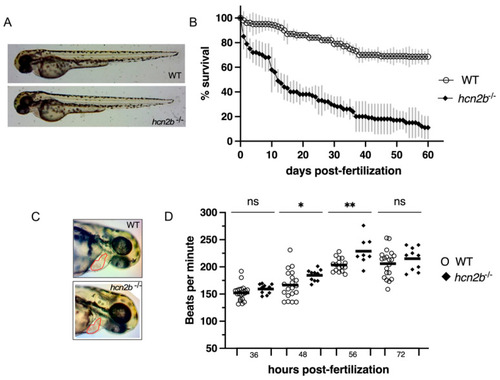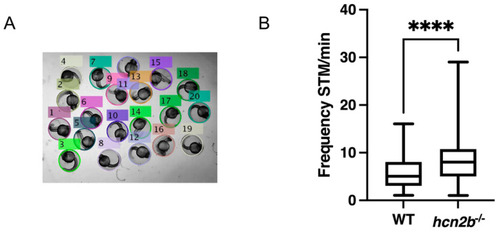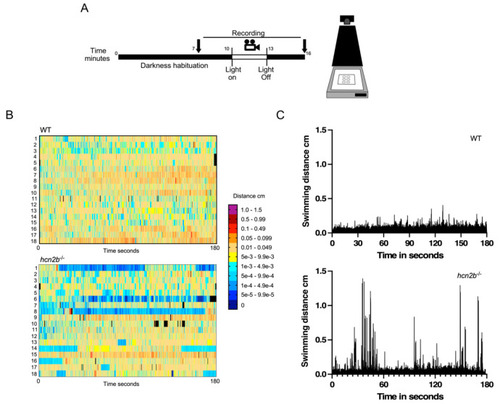- Title
-
Mutants of the Zebrafish K+ Channel Hcn2b Exhibit Epileptic-like Behaviors
- Authors
- Rodríguez-Ortiz, R., Matínez-Torres, A.
- Source
- Full text @ Int. J. Mol. Sci.
|
Zebrafish hcn2b gene, Human HCN2 and zebrafish Hcn2b protein alignment and the Hcn2b Δ89 allele. (A) Exon-intron organization of the zebrafish hcn2b. The three sgRNA Cas9-targeted are in the first exon. Bold grey letters represent the 89 pb deletion of the hcn2b−/− allele. (B) Alignment of predicted primary sequences of human HCN2 and zebrafish Hcn2b. Similar amino acids are highlighted in blue. (C) Primary sequence of the 18 amino acids predicted in the hcn2b−/− allele. |
|
Characterization of the hcn2b−/− mutant. (A) Compared morphology between WT and hcn2b−/− zebrafish mutant at 48 h post-fertilization (hpf): there are no differences in length and pigmentation. (B) Homozygous hcn2b mutants showed a higher mortality rate than controls (4–16% vs. 60–80%). (C) No evident defects were detected during early heart development. Both heart morphology and volume were similar in WT and hcn2b−/− (D). Heart rate showed statistically significant differences between WT and hcn2b−/− larvae at 48- and 56-h post-fertilization. Asterisk indicate statistical significance compared to the control, p < 0.05 (*); p < 0.005 (**). PHENOTYPE:
|
|
Spontaneous tail movement. (A) Twenty-four hours post-fertilization zebrafish larvae in a glass slide; tagged and numbered by MATLAB application ZebraSTM [27]. (B) Frequency of spontaneous tail movements (STM) per one minute of WT versus hcn2b−/− zebrafish mutant. Homozygous hcn2b mutants showed 1.5 times more tail movements compared to WT. Asterisk indicate statistical significance compared to the control, p < 0.0001 (****). PHENOTYPE:
|
|
Motility during dark-light-dark transitions. (A) Video recording protocol. At seven days post-fertilization, larvae were placed in 23 mm diameter wells and covered from light for ten minutes for habituation to darkness, then exposed to three minutes of continuous light and, finally, three minutes of darkness. (B) Heatmap of the swimming behavior of WT and hcn2b−/−. 18 WT and 18 hcn2b mutants are shown. Low activity periods that last over time (in blue) can be interpreted as absence periods (larvae 1, 6 and 8). The high activity in red and purple are fast in a short period in time (see hcn2b−/− (larvae 1, 8, 15 and 18). (C) Swimming distances of 18 WT and 18 hcn2b−/− mutants in the light period. The hcn2b−/− mutants displayed brief peaks as indication of fast hyperactivity episodes. PHENOTYPE:
|
|
Seizures induced by flashlights in the hcn2b−/− mutant. During dark-light transitions, about 7% of adult hcn2b−/− mutants exhibited behavioral seizure activity. (A) First, fish increased their swimming activity (Stage I); then, they showed a rapid “whirlpool-like” circling swimming behavior (Stage II); finally, they exhibited a series of brief clonus-like convulsions that led to a loss of posture and immobility (Stage III). (B) Snap shot sequences of each stage of the seizures caused by flashlight in the hcn2b−/− mutant zebrafish. Images taken from Video S2. PHENOTYPE:
|
|
Novel tank diving assay. (A) Heat maps of three samples (low, medium and high activity) of the WT, hetero- and homozygous hcn2b zebrafish mutants in the swimming performance for six minutes in the novel tank. (B) Total swimming distances of the WT, hetero- and homozygous hcn2b zebrafish mutants. No statistical differences were observed between groups but hcn2b−/− displayed heterogeneous values that corresponded with moments of hyperactivity and immobility. The heat maps and swimming distances were analyzed using EthoVisionXT (Noldus IT, Wageningen, The Netherlands). PHENOTYPE:
|

Unillustrated author statements PHENOTYPE:
|






